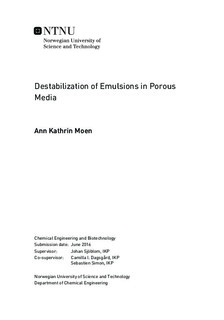| dc.description.abstract | Oil and water can form emulsions with different stability conditions while flowing through the porous systems in an oil reservoir. The stability of different oil-in-water (o/w), water-in-oil (w/o), and oil-in-water-in-oil (o/w/o) emulsion systems during filtration through porous media were studied in this project. Emulsions were stabilized using different surface active components, such as surfactants, particles, and natural indigenous crude oil components.
The influence of surface active components and the dispersed phase on the stability of o/w and w/o emulsions during filtration were investigated by analyzing the droplet size distribution and the content of the dispersed phase in the emulsions by low-field NMR, microscopy and bottle testing. The NMR program required extensive optimization and improvement for several of the emulsion systems.
Surfactant-stabilized emulsion systems (o/w and w/o) were not destabilized within one day after filtration, therefore could it be assumed that flexible droplets which were able to pass the filter pores were formed. Particle-stabilized emulsion systems (o/w and w/o) were destabilized during filtration due to coalescence and breaking of rigid droplets. Particle-stabilized o/w emulsions initially formed larger droplets in the continuous phase than w/o emulsions, which led to increased coalescence, destabilization, and filter clogging during filtration. W/O crude oil emulsions were also destabilized during filtration, but to a lower extent than particle-stabilized emulsions. Free water was formed after filtration of the different crude oil emulsions. Since the crude oil emulsions showed a similar trend as the different particle-stabilized emulsions, it could be concluded that the behavior of crude oil emulsions were closer to particle-stabilized emulsions than surfactant-stabilized emulsions.
Little is known about the flow of multiple emulsions through porous media, therefore analyzing the stability of multiple emulsions during filtration by microscopy was conducted. The multiple (double) o/w/o emulsions were destabilized during filtration: Double emulsions were not observed after filtration, but two different zones were formed, containing clusters or single droplets which indicated coalescence of some droplets in the double emulsions. | |

